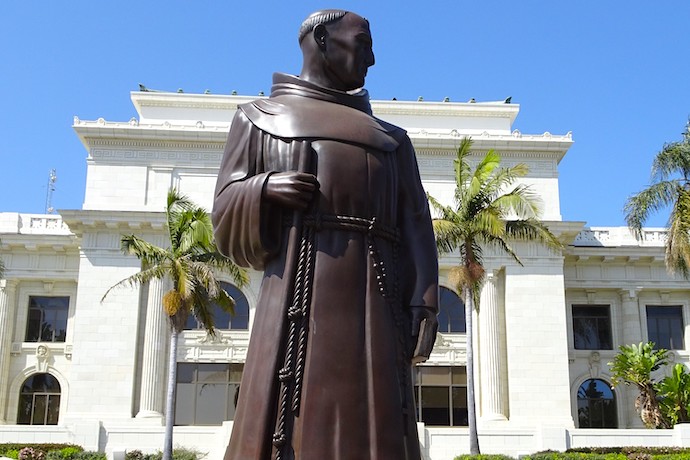What are the responsibilities of the Catholic Church when considering the historical realities of settler colonialism in what we now call the Americas? This question lies at the heart of recent conversations about March’s joint statement from the Vatican repudiating the Doctrine of Discovery—a concept that has underwritten over 500 years of Christian subjugation and genocide of Indigenous peoples, along with the theft of their land.
While the repudiation of the doctrine marks a great success for Indigenous people who’ve been demanding the change for years, the Vatican’s statement conjures a separation of the political and the religious, portraying the 15th century Papal Bulls spawning this doctrine as exclusively political documents that lack theological valence. This political rhetoric, which masks both the history and ethical responsibility of the Catholic Church, allows the Church to ignore its role in the ongoing system of settler colonialism, as well as any accountability to Indigenous communities today.
Although the settler colonial activities that were named in the statement—assimilation policies and Indigenous land dispossession—ignore the realities of Indigenous genocide, they do partially describe the European invasion of Indigenous lands in the late 15th century. And, it should be noted, “assimilation policies” is something of a euphemism given that these policies included the proliferation of Catholic missions and the forced removal of Indigenous children from their families in order to “civilize” them in federal boarding or residential schools.
(It’s helpful to note that family separation as a recent tactic of immigration deterrence is a practice which one Archbishop identified as “a grave sin, immoral (and) evil.” He was, of course, referring to the Trump administration’s policy, not to practices promoted and normalized by his own Church in the past.)
But, unlike contemporary border politics, Indigenous assimilation policies have always been specifically about land dispossession. California missions were eventually secularized—and the land was given to settlers and settler institutions. And as historian Brenda Child established, boarding schools were always about federal access to Indigenous lands.
So, in the five-hundred-year settler colonial project of assimilation and genocide-for-land, what responsibility does the Catholic Church bear? In the joint statement, some key talking points arise providing clues as to the Vatican’s answer to this question. The Vatican asserts, for example, that:
- assimilation policies and land dispossession were “promoted by the governmental authorities of the time”;
- the Doctrine of Discovery was a specifically political debate, “according to which the discovery of lands by settlers granted an exclusive right to extinguish, either by purchase or conquest, the title to or possession of those lands by indigenous peoples”; and that
- it was a debate in which these historical/political papal documents were “manipulated” to “justify immoral acts… that were carried out, at times, without opposition from ecclesiastical authorities.”
Church officials maintain that these bulls were responses to the machinations of 15th century European political powers, and carried no theological weight. The Doctrine of Discovery is therefore not Catholic, or even religious, they argue, but secular and political.
Yet, this rhetorical separation of the political/historical and the theological/religious is puzzling. First, while we’re familiar today with the notion of the separation of church and state, this was a concept that had not yet become fully realized in the European empire at this time. Pope Nicholas V wrote the first two bulls, Dum Diversas (1452) and Romanus Pontifex (1455). At the time, the Catholic Church was itself a political power in Europe. Indeed, Europe was known as Christendom, which some sources have defined as, “a visible society with one head and one hierarchy.”
These first two bulls of the Doctrine of Discovery authorized Alfonso V of Portugal to:
“invade, search out, capture, vanquish, and subdue all Saracens [Muslims] and pagans whatsoever, and other enemies of Christ wheresoever placed… to reduce their persons to perpetual slavery, and to apply and appropriate to himself and his successors the kingdoms, dukedoms, counties, principalities, dominions, possessions, and goods, and to convert them to his and their use and profit.”
The last bull, Inter Caetera, was written by Pope Alexander IV in 1493. It extended the Portuguese privileges to Spain in the lands Columbus stumbled upon when he missed India. Twenty-four years after Inter Caetera, Martin Luther nailed his 95 theses at Wittenberg Castle. Henry the VIII wouldn’t separate from Rome for another 12 years after that. Catholicism was Christianity, and all of Europe fell under the mantle of Catholic society.
Indeed, in Inter Caetera, Pope Alexander VI states that, “we… out of the fullness of our apostolic power, by the authority of Almighty God conferred upon us in blessed Peter and of the vicarship of Jesus Christ, which we hold on earth…give, grant, and assign to you and your heirs and successors [the lands of what is now America].”
How can apostolic power, and divine authority conferred by the vicarship of Jesus Christ be non-theological? How can a power that provides for the giving, granting and assigning of Indigenous lands to European crowns be somehow apolitical? The political and the theological cannot be rationally separated here.
However, as recent findings by the U.S. Department of the Interior illustrate, even today’s notion of the separation of church and state (i.e. the political and the religious) is a myth. This is as true for boarding schools, as it is during presidential elections. Just as it was true a few years ago, when the Philadelphia Archdiocese issued a letter to be read at each mass, urging parishioners to contact their political representatives to advocate against extending the statute of limitations on child sex abuse cases.
This rhetoric of separation between the political and the religious arises again in Pope Francis’s recent apology for the atrocities committed by Catholics operating Canadian residential schools. As he expressed, “many Christians supported the colonizing mentality of the powers that oppressed the indigenous peoples.” In Francis’s view, a number of individual Christians succumbed to the ideologies or worldviews of the unnamed “powers” that oppressed Indigenous peoples. For Francis and others, settler colonialism is about political powers and individual Christians—not the Church as an institution.
Like the apologies of Pope Francis, the joint statement on the Doctrine of Discovery obscures the inseparable theological and political force of the modern church. The use of these bulls by European powers were not anomalies or bad faith readings. They were entirely consistent with the norms of religious political authority at the time. Ad hoc responses to ad hoc problems are, when issued with religious authority, specifically theological responses to these problems. Nicholas V and Alexander IV used their authority specifically as Vicars of Christ to instruct Portugal and Spain on the correct theological anthropology and correlated land-grab. At the very least, this locates the Catholic church as the cue stick on the settler colonial ball that set into motion 500 years of Indigenous genocide in the service of European land possession.
Any land the Church owns in the Americas is stolen land. It was stolen because of a series of documents that stated it should be stolen for White, European Christians. The very admission that these bulls were in error, means that their genocidal land-grabbing theologies and logics were and are wrong. Other Christian denominations have already begun reckoning with their historical complicity around these papal bulls, and their contemporary accountability to Indigenous people. Indigenous people should never have been enslaved or annihilated. These lands were never empty or forfeit. Yet, with one exception on this continent, the Church retains possession of this stolen land—possession it now underscores as erroneous.
It’s time for the Catholic Church to give the land back.





